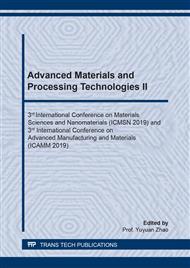p.75
p.85
p.92
p.98
p.106
p.115
p.121
p.128
p.135
Finite Element Simulation of the Yoke Spline under Hot Forging Process
Abstract:
Nowadays, finite element method (FEM) has been widely used to forecast metal forming process, to analysis problems of workpiece, to decrease production cost, and to save time of die design. This work studied the use of FEM as a tool to design a hot forging die for producing an automotive part named Yoke Spline. The part was made from carbon steel grade S45CVL0. There are three processes to produce Yoke Spline, including the buster, rougher, and finisher processes. The objective of the study was to increase efficiency of production by 5%. To achieve this objective, it was necessary to design a new die in the buster process by using FEM to analyze the die size and shape. The new die must produce the workpieces without any defects. The defects regularly found in the forging workpieces are the dimension out of specification, the under filling, and the crack. The sizes of the buster upper die cover are the width and depth. The die width of 44.5, 46.5 and 49.5 millimeters and the die depth of 25, 28 and 31 millimeters were used in the hot forging simulation. From FEM simulation results, it was found that the die width of 46.5 millimeters and the die depth of 28 millimeters were the best to form workpieces without any defects. In summary, the simulation and experimental results were compatible.
Info:
Periodical:
Pages:
106-111
Citation:
Online since:
March 2020
Authors:
Price:
Сopyright:
© 2020 Trans Tech Publications Ltd. All Rights Reserved
Share:
Citation:


